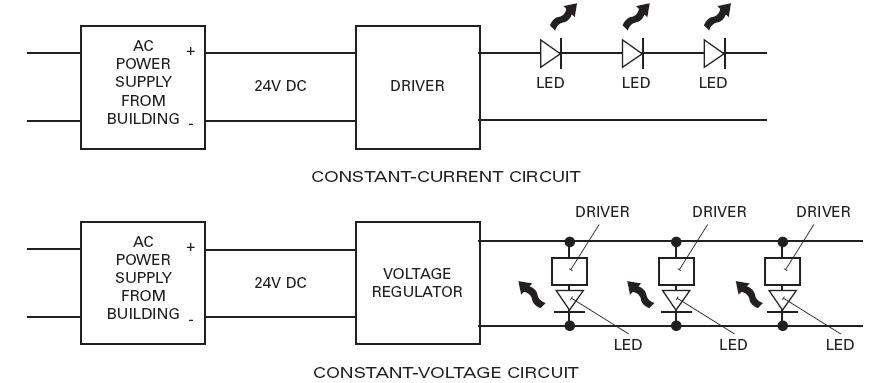LED color-varying systems use either RGB (red-green-blue) or RGBA (red-green-blue-amber) color mixing of LED lamps of each color. RGB/RGBA control is similar to dimming, except that a dimmable driver must be provided for each color in each pixel. A pixel is the smallest addressable cluster of red, green, blue, and amber LEDs. In order for SSL systems to “chase” or display low-resolution video, this means you need to employ many drivers as well as require communications wiring and electronics.
For the purpose of architectural lighting, some manufacturers of SSL luminaires use drivers that can be dimmed with ordinary incandescent-style dimmers. But because simple incandescent circuits can experience interaction problems with SSL power supplies, better dimming range and smoothness often can best be obtained using dimmable drivers that are controlled by DALI, 0- to 10-volt, or DMX (theatrical) control circuits. Note that most of these circuits use special dimming circuits that are installed between the constant-voltage driver and those LEDs that the circuit is intended to regulate.
MAKE IT SIMPLE, PLEASE Just as in the early days of compact fluorescent lamps, the LED industry is a long way from standardization. For the time being it will be up to the individual lighting designer, engineer, or contractor to figure out the intent of the often poorly written literature from the manufacturer. We are sometimes seduced by attractive, state-of-the-art products only to discover that it takes an electronics engineer to make the lighting perform properly. But it is hard to blame the luminaire manufacturers when the problem lies with the makers of the components.
We need standards in solid-state lighting that go well beyond the lumen measurement, efficacy, and life testing that have dominated solid-state lighting discussions to date. For instance, due to their poor 70 percent efficiency, drivers are often avoided when the energy efficiency of solid-state lighting is discussed. This is unfortunate. If we’re going to take full advantage of LEDs, we need standardized and more manageable control components that make sense in the existing world of 120V and 277V AC power, the National Electric Code, energy codes, and the skills of electricians and contractors. As it is, LEDs have already developed a reputation for failing to meet rated performance and life. If the wiring and dimming remains complicated, there will be an almighty push back that will make us all hope for the invention of a high-efficiency incandescent lamp.
